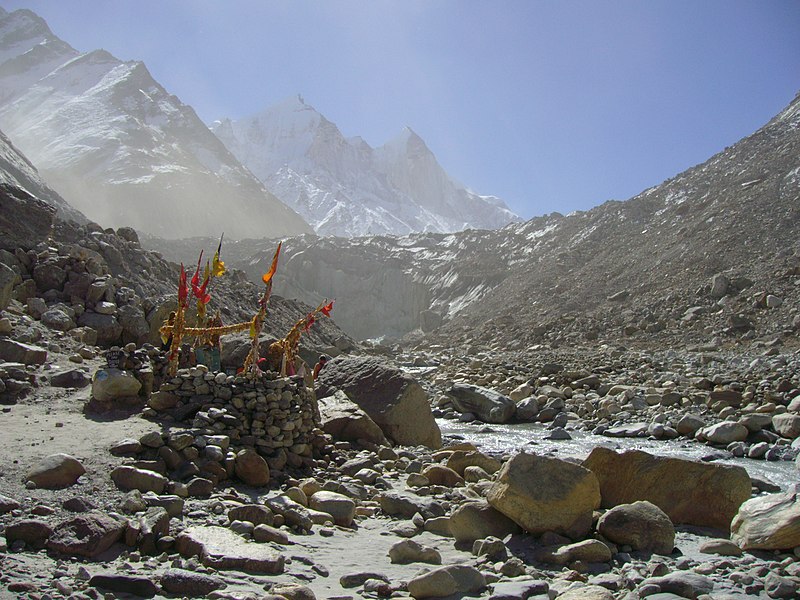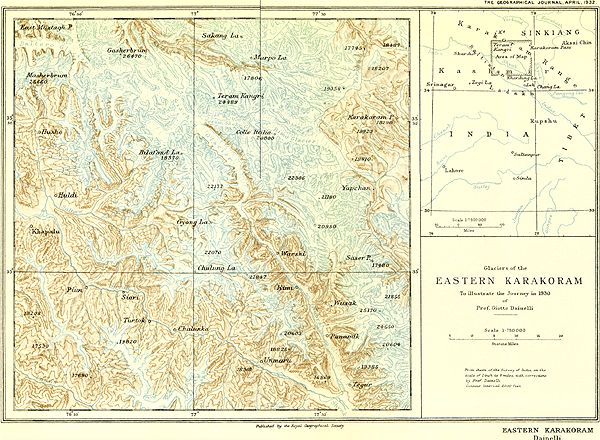 |
| Gangotri glacier in India, source of the Ganges. Wikimedia Commons |
Why are climate change exhibitions always so dark?
Like a lot of climate change-themed exhibitions I've been to, the striking visual representations were made to stand-out amid an otherwise darkened room. The walls of deep blue provided an immersive contrast to the shimmering whites of the snow-bound Himalayan peaks. Breashears' striking landscape photography shared the space with a number of examples of mountaineering paraphernalia, huge reproductions of IPCC graphs and copies of the written accounts of earlier explorers of the Himalayan region.
Much of the exhibition revolved around the well-established trope of presenting twin images of the same glacier separated only by a span of time. We see glaciers photographed from almost exactly the same position, in the same conditions, as they had been decades before. The retreat of the glaciers between the capturing of the photographs is plain and striking. Even the most casual observer becomes enrolled in the project of identifying change in a complex landscape.

 |
| West Rongbuk glacier in Tibet, in 1921 (top) and 2008 (bottom). From http://www.glacierworks.org/glacier/west-rongbuk-glacier |
This representational strategy is a great example of what Bruno Latour calls "optical consistency". In his 1990 piece on 'Drawing things together', Latour discusses the role of a mechanized, consistent form of sight in producing powerful and mobile forms of 'inscription'. Optically consistent representations allow images of different objects to be compared, combined, averaged and so on - all the analytic strategies of modern science. Lorraine Daston and Peter Galison would perhaps locate the emergence of this strategy of optical consistency in the period between the 18th and 19th centuries when 'objectivity' came to be sought in the mechanized production of images, rather than in the discerning eye and artistic hand of the esoteric scientific expert.
Bruno Latour's work emphasises the material work that goes into generating optical consistency. This work was on show at the MIT Museum, in the boots, ropes and ice picks encased in glass display cases. The visitor becomes most immersed in this process in a corner of the exhibition which features 360-degree, 12-foot diameter photographic panorama of a Himalayan mountaintop vista. The visitor is invited to stand on an image of snowy boot prints on the floor, and to cast their eye around the landscape as it was seen by the intrepid mountaineer a few years ago.
There's much to recommend this exhibition, particularly its interactivity and the way in which the knowledge claims being made in the new photographs are set within a rich historical context. However, like in much of Latour's work on scientific representation, the politics of knowledge production are largely obscured.
Picture politics
By emblazoning quotations from 19th and early 20th century explorers on the walls of the exhibition room, it is clear that this new project of knowledge production is seen as a continuation of the tradition of the Great Explorer. Brave European and North American men endure conditions of great hardship in unknown and exotic landscapes, all in the name of knowledge accumulation. A quote from a recent National Research Council document is used to emphasise the continued importance of exploration, and the uncertainty of satellite measurements of glaciers is used bolster a 'boots on the ground' ethic of empirical validation through physical human presence.
I don't know whether the notion of exploration holds greater currency in the US than in the UK. I struggle to imagine that an exhibition of this kind in the UK would claim the same position in a lineage of exploration, given how tightly that lineage is intertwined with the history of European colonialism. However, the privileging of direct observation of glaciers over remote observation is something I encountered frequently during my recent fieldwork in India. Interview respondents would often claim credibility for their arguments about the general state of the Himalayan glaciers by prefacing them with statements about having stood on the glaciers themselves.
 |
| Map of the eastern Karakoram range by Giotto Dainelli,1932 |
 |
| A more nuanced account of climate change and glaciers is offered by Mark Carey in this 2010 book. |
No comments:
Post a Comment